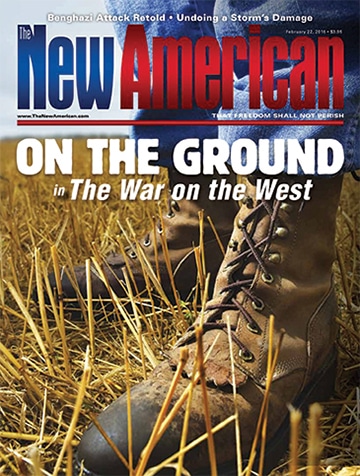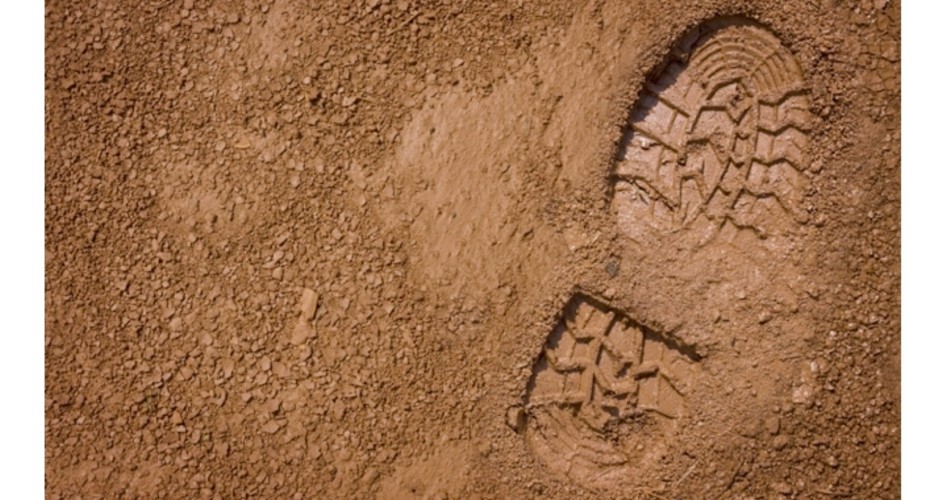The Federal Bootprint
In crafting a constitution to create a central, federal government, the American Founding Fathers were careful to strictly shackle it so that this proposed new entity would stay within its defined, delegated powers, so that it would not be able to overawe or overwhelm the individual states that were to be its sovereign masters in all powers not expressly transferred to the national government. Those delegated powers are enumerated, most particularly, in Article 1, Section 8 of our U.S. Constitution. One of the most important features of this section is the limitation on the federal government’s ownership of land.
According to the Constitution, our law of the land, “The Congress shall have Power … To exercise exclusive Legislation in all Cases whatsoever, over such District (not exceeding ten Miles square) as may, by Cession of particular States, and the Acceptance of Congress, become the Seat of the Government of the United States, and to exercise like Authority over all Places purchased by the Consent of the Legislature of the State in which the Same shall be, for the Erection of Forts, Magazines, Arsenals, dock-Yards, and other needful Buildings.”
The federal government was allowed to have a 10-mile square (100 square miles) for a seat of government. Property for “Forts, Magazines, Arsenals,” etc., for national defense purposes, could be purchased from the states if the state legislatures consented. That’s it. Under Article IV, the federal government is allowed to acquire new territory, which is to be “disposed” of by turning it over to the new state government when the territory is admitted into statehood. Newly created states are to be admitted on an “equal footing” with the original 13 states, meaning with full sovereignty over their lands, not with a distant federal landlord controlling 30 percent, 50 percent, or 90 percent of their land and resources. As The New American explained in some detail in a May 2014 article, “Feds vs. the West,” virtually all of the states that were admitted to the Union after the original 13 found that they had to fight in Congress and the courts to get the federal government to relinquish its hold on their lands. Citizens of the 12 western states (Alaska, Washington, Nevada, Utah, Oregon, Idaho, Arizona, California, Wyoming, New Mexico, Montana, and Colorado) are now trying to do the same thing, to obtain their long-delayed “equal footing” and evict the unconstitutionally created federal bureaucracies (BLM, Forest Service, Fish & Wildlife Service, etc.) from their land so that they can manage their own affairs the same as the other states do.
It is difficult for people who do not feel the oppressive heel of federal agencies on their necks to understand the depth of detestation toward these agencies by their fellow citizens who do live under the federal boot; whose daily lives are made miserable and whose livelihoods and life savings are threatened by unjust and capricious federal regulations and unconstitutional (and often criminal) actions by federal bureaucrats; whose once-prosperous communities have been driven, or are being driven, into destitution and bankruptcy. In the Western states, the federal boot is heavy indeed — and getting heavier, as federal agencies continue their decades-long buying spree (with the taxpayers’ money, of course) of millions more acres, even while admitting they are tens of billions of dollars behind on deferred maintenance of the lands they already own.
In November 2015, the Committee on Natural Resources of the U.S. House of Representatives released “The Federal Footprint,” a detailed, layered map of the United States showing the 640 million acres of “public lands” claimed by the federal government. Here are some of the striking details provided by that inventory of Fedgov properties:
Bureau of Land Management — 247.3 million acres: The BLM, an agency of the Department of the Interior, is the biggest of the federal landlords. It manages (or mismanages, according to critics) lands totaling some 247.3 million acres — an area larger than the states of Arizona, Colorado, Iowa, and Nevada combined — with 99.9 percent of those lands being concentrated in 11 Western states and Alaska.
Forest Service — 193.1 million acres: There are some 154 National Forests and 20 National Grasslands that total 193.1 million acres — an area more than twice the size of Montana. National Forests and Grasslands are administered by the Forest Service, an agency of the Department of Agriculture.
Fish and Wildlife Service — 89.1 million acres: There are 560 units in the National Wildlife Refuge System, which includes 267 individual refuges and 38 management districts. These units total over 89.1 million acres of federal land nationwide, more than the states of Utah and North Carolina combined. Refuges are administered by the Fish and Wildlife Service, an agency of the Department of the Interior.
National Park Service — 84 million acres: The National Park system is comprised of 408 sites spread across 84 million acres, an area slightly larger than the states of New Mexico and New Hampshire combined. This includes historic parks or sites, national monuments, national parks, battlefields, preserves, recreation areas, seashores, parkways, lakeshores, and reserves. All of these are administered by the National Park Service, an agency of the Department of the Interior.
Bureau of Indian Affairs — 55 million acres: The BIA, an agency of the Department of the Interior, is responsible for the administration and management of 55 million acres in estates held in trust by the United States for American Indians, Indian tribes, and Alaska Natives. These lands equal an area larger than the entire state of Idaho.
Bureau of Reclamation — 7.1 million acres: The BOR, an agency of the Department of the Interior, manages 7.1 million acres of land and easements, as well as 337 water reservoirs across 17 Western states, an area slightly larger than the state of Massachusetts.
Department of Defense — 14.4 million acres: The DOD claims some 14.4 million acres of land in the United States, more than the combined area of Delaware, New Jersey, Rhode Island, and Vermont.
Outer Continental Shelf — 1.712 billion acres: The OCS area encompasses 1.712 billion acres and lies offshore in between where state offshore jurisdiction ends — nine nautical miles off the coasts of Florida and Texas, and three nautical miles offshore for all other states — and extending to 200 nautical miles out to sea. This huge area falls under the control of the Bureau of Offshore Energy Management (BOEM) and the Bureau of Safety and Environmental Enforcement (BSEE), both agencies of the Department of the Interior.
But the “Federal Footprint Map” does not tell the whole story of the federal landlord in the West. A crucially important issue not covered by the map is the control exercised by federal agencies over the remaining private land and water, as well as over state, county, municipal, or other types of publicly owned lands in the Western states. Private landowners are regularly subjected to “takings” of their property rights under the guise of protecting the environment through Wild & Scenic Rivers designation, critical habitat (for so-called endangered species) designation, wetlands designation, or National Heritage Area designation.
Also not shown on the map is the increasing footprint of tax-exempt foundations and non-profit trusts (such as the Nature Conservancy, American Prairie Reserve, etc.) that are buying up millions of acres through various extortion schemes in which they conspire with federal agencies to drive private property owners off their land. Utilizing a combination of lawsuits and onerous regulations, the enviro-Fedgov tag teams force distressed owners into the position of “willing sellers” — and then often scoop up the “bargain property” for pennies on the dollar. These trust properties are still listed as “private property,” but they often are taken off the tax rolls, thus increasing the tax burden on the remaining genuine, productive private-property owners.
A somewhat better appreciation of the impact of the Fedgov bootprint can be obtained by translating the millions of acres of land “owned” by the federal government in the Western states into the percentage of land that amounts to in each state:
Nevada: 84.5 percent
Alaska: 69.1 percent
Utah: 57.4 percent
Oregon: 53.1 percent
Idaho: 50.2 percent
Arizona: 48.1 percent
California: 45.3 percent
Wyoming: 42.4 percent
New Mexico: 41.8 percent
Colorado: 36.6 percent
Washington: 30.3 percent
Montana: 29.9 percent
On the practical level, it is patently ludicrous for the federal government, which is drowning in debt from here to eternity, to continue purchasing (or confiscating) more property, while continuing to mismanage and destroy that with which it has already been entrusted. But that is the case. One measure of the problem is the “deferred maintenance” issue mentioned earlier, which has been an ongoing crisis for decades. The latest report on this matter (April 2015) from the nonpartisan Congressional Research Service (CRS) found that the four principal culprits — the National Park Service (NPS), Forest Service, Fish and Wildlife Service, and Bureau of Land Management — “had a combined deferred maintenance estimated at between $16.31 billion and $21.43 billion.”
The NPS, the largest offender, which has charge over our National Parks, has been looting the treasury to buy still more land while allowing our “national jewels” to fall into ruin. Roads, bridges, culverts, buildings, fences, hiking trails, campgrounds, picnic grounds, shelters, restrooms, and other assets that are not maintained quickly deteriorate, and the cost of repairing and/or replacing them becomes astronomical: now over $11 billion for the NPS.
As we explained in some detail in our article “Feds vs. the West,” (May 19, 2014), there is no practical, moral, or constitutional basis for the federal government to continue holding on to vast swaths of the American West. Our Founders never intended the national government to exercise permanent ownership or control over these huge expanses. We do not see this massive federal imprint on the states of the Eastern seaboard. Many of the states of the Midwest, the Great Lakes, and the Gulf Coast had to fight in Congress and in the courts to force the Feds to properly “dispose” of the “public lands,” by fully transferring them to the states, so that they would enjoy sovereign “equal footing” with the original 13 states. The people of the Western states who are now calling for their right to “equal footing” should be applauded for following this very American course. It is insulting to claim or imply that the states, counties, municipalities, and private citizens of the West are less capable of managing their own affairs than their fellow citizens, or that they will be more destructive of the “national treasures” than the Fedgov “servants” who are already accomplishing that destruction.
Photo at top: AP Images


